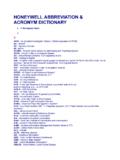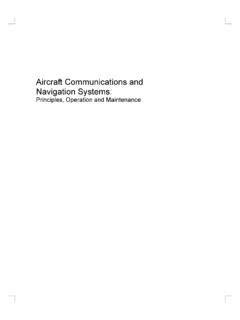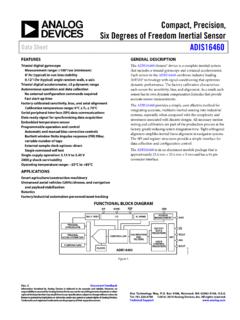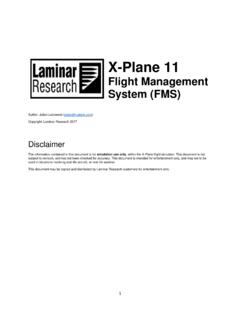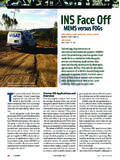Transcription of Ten Degrees of Freedom Inertial Sensor with …
1 Ten Degrees of Freedom Inertial Sensor with Dynamic Orientation Outputs Data Sheet adis16480 Rev. G Document Feedback Information furnished by analog devices is believed to be accurate and reliable. However, no responsibility is assumed by analog devices for its use, nor for any infringements of patents or other rights of third parties that may result from its use. Specifications subject to change without notice. No license is granted by implication or otherwise under any patent or patent rights of analog devices . Trademarks and registered trademarks are the property of their respective owners. One Technology Way, Box 9106, Norwood, MA 02062-9106, Tel: 2012 2017 analog devices , Inc. All rights reserved. Technical Support FEATURES Dynamic angle outputs Quaternion, Euler, rotation matrix (pitch, roll) and (yaw) static accuracy Triaxial, digital gyroscope, 450 /sec dynamic range orthogonal alignment error 6 /hr in-run bias stability / hr angular random walk nonlinearity Triaxial, digital accelerometer, 10 g Triaxial, delta angle and delta velocity outputs Triaxial, digital magnetometer, gauss Digital pressure Sensor , 300 mbar to 1100 mbar Adaptive extended Kalman filter Automatic covariance computation Programmable reference reorientation Programmable Sensor disturbance levels Configurable event-driven controls Factory-calibrated sensitivity, bias, and axial alignment Calibration temperature range: 40 C to +85 C SPI-compatible serial interface Programmable operation and control 4 FIR filter banks, 120 configurable taps Digital I/O: data-ready alarm indicator, external clock Optional external sample clock input.
2 Up to kHz Single-command self-test Single-supply operation: V to V 2000 g shock survivability APPLICATIONS Platform stabilization, control, and pointing Navigation Instrumentation Robotics GENERAL DESCRIPTION The adis16480 iSensor device is a complete Inertial system that includes a triaxial gyroscope, a triaxial accelerometer, triaxial magnetometer, pressure Sensor , and an extended Kalman filter (EKF) for dynamic orientation sensing. Each Inertial Sensor in the adis16480 combines industry-leading iMEMS technology with signal conditioning that optimizes dynamic performance. The factory calibration characterizes each Sensor for sensitivity, bias, alignment, and linear acceleration (gyroscope bias). As a result, each Sensor has its own dynamic compensation formulas that provide accurate Sensor measurements. The sensors are further correlated and processed in the extended Kalman filter, which provides both automatic adaptive filtering, as well as user-programmable tuning.
3 Thus, in addition to the IMU outputs, the device provides stable quaternion, Euler, and rotation matrix outputs in the local navigation frame. The adis16480 provides a simple, cost-effective method for integrating accurate, multiaxis Inertial sensing into industrial systems, especially when compared with the complexity and investment associated with discrete designs. All necessary motion testing and calibration are part of the production process at the factory, greatly reducing system integration time. Tight orthogonal alignment simplifies Inertial frame alignment in naviga-tion systems. The SPI and register structure provide a simple interface for data collection and configuration control. The adis16480 uses the same footprint and connector system as the ADIS16488A, which greatly simplifies the upgrade process. It comes in a module that is approximately 47 mm 44 mm 14 mm and has a standard connector interface. The adis16480 provides an operating temperature range of 40 C to +105 C.
4 FUNCTIONAL BLOCK DIAGRAM CLOCKTRIAXIALGYROTRIAXIALACCELPOWERMANAG EMENTCSSCLKDINDOUTGNDVDDTEMPVDDDIO1 DIO2 DIO3 DIO4 VDDRTCRSTSPITRIAXIALMAGNPRESSURESELF-TES TI/OALARMSOUTPUTDATAREGISTERSUSERCONTROL REGISTERSADIS16480 CONTROLLERCALIBRATIONEXTENDEDKALMANFILTE RDIGITALFILTERING10278-001 Figure 1. adis16480 Data Sheet Rev. G | Page 2 of 44 TABLE OF CONTENTS Features .. 1 Applications .. 1 General Description .. 1 Functional Block Diagram .. 1 Revision History .. 3 Specifications .. 4 Timing Specifications .. 7 Absolute Maximum Ratings .. 9 ESD Caution .. 9 Pin Configuration and Function Descriptions .. 10 Typical Performance Characteristics .. 11 Basic Operation .. 12 Register Structure .. 12 SPI Communication .. 13 Device Configuration .. 13 Reading Sensor Data .. 13 User Registers .. 14 Output Data Registers .. 18 Inertial Sensor Data Format .. 18 Rotation Rate (Gyroscope) .. 18 Acceleration .. 19 Delta Angles .. 19 Delta Velocity .. 20 Magnetometers .. 21 Roll, Pitch, Yaw Angles.
5 21 Initial Conditions .. 21 Rotation Matrix Data .. 22 Barometer .. 23 Internal Temperature .. 23 Status/Alarm Indicators .. 24 Firmware Revision .. 25 Product Identification .. 25 Digital Signal Processing .. 26 Gyroscopes/Accelerometers .. 26 Averaging/Decimation Filter .. 26 Magnetometer/Barometer .. 26 FIR Filter Banks .. 27 Extended Kalman Filter .. 29 Algorithm .. 29 Covariance Terms .. 29 Reference Frame .. 30 Reference Transformation Matrix .. 30 Declination .. 31 Adaptive Operation .. 31 Calibration .. 33 Gyroscopes .. 33 Accelerometers .. 34 Magnetometers .. 34 Barometers .. 36 Restoring Factory Calibration .. 36 Point of Percussion Alignment .. 36 Alarms .. 37 Static Alarm Use .. 37 Dynamic Alarm Use .. 37 System Controls .. 39 Global Commands .. 39 Memory Management .. 39 General-Purpose I/O .. 40 Power Management .. 40 Applications Information .. 42 Mounting Tips .. 42 E v a l u a t i o n To o l s .. 43 Power Supply Considerations .. 43 Outline Dimensions.
6 44 Ordering Guide .. 44 Data Sheet adis16480 Rev. G | Page 3 of 44 REVISION HISTORY 10/2017 Rev. F to Rev. G Changes to General Description Section .. 1 Changes to Logic 0 Input Current, IIL Parameter, Table 1 .. 5 Added Note 7, Table 1; Renumbered Sequentially .. 6 Changed PC-Based Evaluation, EVAL-ADIS Section to PC-Based Evaluation, EVAL-ADIS2 Section .. 43 Changes to PC-Based Evaluation, EVAL-ADIS2 Section .. 43 10/2016 R e v. E to R e v. F Changes to Figure 19 .. 18 Changes to Figure 30 and Figure 31 .. 43 6/2015 R e v. D t o R e v. E Changes to Figure 28 .. 42 Changes to Ordering Guide .. 44 2/ 2015 R e v. C to R e v. D Changes to Features Section and General Description Section .. 1 Changes to Table 1 .. 4 Changes to t2 Parameter, Table 2, and Figure 2 .. 7 Added Table 3; Renumbered Sequentially .. 7 Changes to Figure 4 .. 8 Change to Operating Temperature Range, Table 4 .. 9 Change to Dual Memory Structure Section .. 13 Change to Linear Acceleration on Effect on Gyroscope Bias Section.
7 33 Changes to Input Sync/Clock Control Section, Table 151, and Power Management Section .. 40 Changes to Ordering Guide .. 44 4/2014 Rev. B to Rev. C Changes to Features Section .. 1 Change to Nonlinearity, Barometer Parameter, Endnote 5, and Endnote 12, Table 2 .. 5 Changes to Table 9 .. 16 Changes to Delta Angles Section .. 19 Changes to Magnetometer/Barometer Section .. 25 Changes to Linear Acceleration on Effect on Gyroscope Bias Section .. 32 Change to Manual Bias Correction Section .. 33 Change to Static Alarm Use Section .. 36 Change to Software Reset Section .. 38 Changes to General Purpose I/O Section .. 39 Changes to Mounting Tips Section .. 41 1/ 2014 Rev. A to Rev. B Moved Revision History .. 3 Change to t2 Parameter, Table 7 Changes to Figure 6 .. 9 Changes to Delta Angles Section .. 18 Changes to Delta Velocity Section and Table 34 .. 19 Changes to Initial Conditions Section .. 20 Changes to Table 42 .. 21 Changes to Status/Alarm Indicators Section.
8 23 Changes to Table 94, Automatic EKF Divergence Reset Control Bit Section, and Body Frame/Local Navigation Frame Bit Section .. 30 Change to Magnetometers Section .. 33 Changes to Table 146 .. 38 Deleted Prototype Interface Board Section and Mechanical Design Tips Section .. 39 Added Mounting Tips Section .. 41 Added Evaluation Tools Section and Power Supply Considerations Section .. 42 Updated Outline Dimensions .. 43 Changes to Ordering Guide .. 43 2/2013 R e v. 0 t o R e v. A Changes to Ta b l e 1 .. 3 Changes to Table 2 and Figure 2 .. 6 Changes to Table 9 .. 12 Changes to Table 94, Bit 3 and Body Frame/Local Navigation Frame Bit Section .. 29 Deleted Installation Tips Section; Added Mechanical Design Tips Section; Changes to Prototype Interface Board Section, Figure 29, and Figure 30 .. 39 Added Connector-Up Design Tips Section Figure 31, and Figure 32, Renumbered Sequentially .. 40 5/ 2012 Revision 0: Initial Version adis16480 Data Sheet Rev. G | Page 4 of 44 SPECIFICATIONS TA = 25 C, VDD = V, angular rate = 0 /sec, dynamic range = 450 /sec 1 g, 300 mbar to 1100 mbar, unless otherwise noted.
9 Table 1. Parameter Test Conditions/Comments Min Typ Max Unit ANGLE OUTPUTS Euler Dynamic Range Yaw and roll (Euler) 180 Degrees Pitch (Euler) 90 Degrees Rotation matrix, quaternion 180 Degree Sensitivity Degrees /LSB Static Accuracy1 Pitch and roll Degrees Yaw Degrees Dynamic Accuracy1 Pitch and roll Degrees Yaw Degrees GYROSCOPES Dynamic Range 450 480 /sec Sensitivity x_GYRO_OUT and x_GYRO_LOW (32-bit) 10 7 /sec/LSB Repeatability2 40 C TA +85 C 1 % Sensitivity Temperature Coefficient 40 C TA +85 C, 1 35 ppm/ C Misalignment Axis to axis Degrees Axis to frame (package) Degrees Nonlinearity Best-fit straight line, FS = 450 /sec % of FS Initial Bias Error /sec In-Run Bias Stability 1 /hr Angular Random Walk 1 / hr Bias Temperature Coefficient 40 C TA +85 C, 1 /sec/ C Linear Acceleration Effect on Bias Any axis, 1 (CONFIG[7] = 1) /sec/g Output Noise No filtering /sec rms Rate Noise Density f = 25 Hz, no filtering /sec/ Hz rms 3 dB Bandwidth 330 Hz Sensor Resonant Frequency 18 kHz ACCELEROMETERS Each axis Dynamic Range 10 g Sensitivity x_ACCL_OUT and x_ACCL_LOW (32-bit) 10 8 g/LSB Repeatability 40 C TA +85 C % Sensitivity Temperature Coefficient 40 C TA +85 C, 1 25 ppm/ C Misalignment Axis to axis Degrees Axis to frame (package) Degrees Nonlinearity Best-fit straight line, 10 g % of FS Bias Repeatability3 40 C TA +85 C, 1 16 mg In-Run Bias Stability 1 mg Velocity Random Walk 1 m/sec/ hr Bias Temperature Coefficient 40 C TA +85 C mg/ C Output Noise No filtering mg rms Noise Density f = 25 Hz, no filtering mg/ Hz rms 3 dB Bandwidth 330 Hz Sensor Resonant Frequency kHz Data Sheet adis16480 Rev.
10 G | Page 5 of 44 Parameter Test Conditions/Comments Min Typ Max Unit MAGNETOMETER Dynamic Range gauss Sensitivity mgauss/LSB Initial Sensitivity Tolerance 2 % Sensitivity Temperature Coefficient 1 275 ppm/ C Misalignment Axis to axis Degrees Axis to frame (package) Degrees Nonlinearity Best fit straight line % of FS Initial Bias Error 0 gauss stimulus 15 mgauss Bias Temperature Coefficient 40 C TA +85 C, 1 mgauss/ C Output Noise No filtering mgauss Noise Density f = 25 Hz, no filtering mgauss/ Hz 3 dB Bandwidth 330 Hz BAROMETER Pressure Range 300 1100 mbar Extended 10 1200 mbar Sensitivity BAROM_OUT and BAROM_LOW (32-bit) 10 7 mbar/LSB Error with Supply %/V Total Error mbar Relative Error4 40 C to +85 C mbar Nonlinearity5 Best fit straight line, FS = 1100 mbar % of FS 40 C to +85 C % of FS Linear-g Sensitivity 1 g, 1 mbar/g Noise mbar rms TEMPERATURE Sensor Scale Factor Output = 0x0000 at 25 C ( 5 C)










